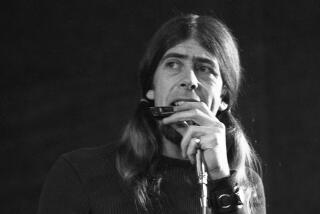Totally Amped : The sound of rock is kept by Brent Magnano, owner of a guitar shop in Huntington Beach. His collection of vintage Marshall gear may be the world’s largest.
- Share via
HUNTINGTON BEACH — --People noticed when the Marshall came to Orange County.
Instead of a drawling “pardner” with six-guns and a badge, this Marshall got its authority from 100 watts and eight 12-inch speakers, and it spoke with a decidedly British accent. We talk here of the English-made Marshall guitar amplifier, the throaty, Harley-like tones which some aficionados describe as “the sound of rock.”
They first started popping up on local stages around 1968. One such occasion was the Newport Pop Festival at the Orange County Fairgrounds, where the power trio Blue Cheer, backed by a wall of Marshall amps, was reported to have been heard more than two miles away across Upper Newport Bay. This writer first saw the amps at the Anaheim Convention Center in April of that year; huge things--looming somewhere in size between a refrigerator and the “2001” monolith--that physically dwarfed the members of Cream, while making their music sound louder than God.
The towering earaches indirectly had their origin in Orange County. In 1962, when London music shop owner Jim Marshall and his employee Ken Bran decided to make an amplifier, they dissected a Fullerton-made 1959 Fender Bassman amp and copied it as best they could. Then at the behest of guitarists like the Who’s Pete Townshend, they started designing them bigger and meaner.
According to Marshall historian Michael Doyle, “Fender was embarrassed that their amps distorted; Marshalls were the first amps designed to distort, and that’s what rock ‘n’ roll is all about.” The aggressive amps became an essential part of the sound of Jimi Hendrix, Eric Clapton, Eddie Van Halen and a legion of other guitarists. Today newer Marshalls are ubiquitous in heavy rock, while the original 1960s models are revered icons.
It is indeed in a hushed, reverential tone that Brent Magnano talks about the first time he plugged into a Marshall 100-watt amp back in his Waterbury, Conn., hometown in 1976.
“You can play all those Hendrix and Cream licks through another amp, but when you get a Marshall, it’s incredible, just like they sounded on the record,” he said. “It sounded that good. You know that feeling when you’re younger, before you screw up your hearing when you can really feel sound, how it hits you in the chest? That was it. There was no turning back after that.”
Evidently not. Today, the 32-year-old Magnano has what may be the world’s largest collection of vintage Marshall gear, about 250 pieces, some of which reside at his Huntington Beach shop, Guitar Oasis. It’s a cumbersome bunch of stuff: A full Marshall stack (two speaker cabinets and an amplifier “head” on top) is about 6 1/2 feet tall. Like pancakes, they also come in half-stacks.
Along with electronic differences, some of the variations in his collection are cosmetic, including a number of rare custom-color amps, covered in blond, purple, red and other shades of vinyl. For the photo accompanying this story, he recently lined these and other historically significant Marshalls up in a row, which begged the question:
“Do you ever feel tempted to play dominoes with these things?”
“No, but that happened to me once, not intentionally,” he said. “I had a shipment come in from England of about 80 Marshall heads. I stacked them in my basement back East, and I stacked them a little too high, eight or nine high. A couple of days later I was trying to move them around to see what I had, and the whole pile started to move forward, and I couldn’t do anything but scream.
“You wanna hear a guy yell? You know that tree that falls in the forest with no one around to hear it? That was me in my basement.”
A couple of the amps were badly damaged, while another 20 had light damage, and Magnano survived to collect another day.
*
Though his collection looks like it was the product of decades of work--made more difficult by the fact that many of Marshall’s early models were never imported to the States--he has only been actively collecting for the past five years.
Magnano was in his teens when he heard, and subsequently bought, his first Marshall. Until 1983 he was a working musician, which, as those in the music business know, means he wasn’t in a financial position to collect much of anything. He quit gigging in 1983--”I was tired of being poor”--and wound up investing in real estate, while dealing in rare guitars and amps on the side.
Magnano saw the end of the real estate boom coming in 1989 and cashed out. In the meantime he’d gone to a rare guitar show in Texas and was floored to discover early ‘60s Marshalls that he’d never known existed. He bought three, and what he admits to be “a ridiculous obsession” took off from there.
“I had a few bucks left over from the real estate to invest,” he said. “I guess I could have put it in CDs or mutual funds, which were pretty high at the time, and done that with a lot less hassle and less headaches. But to me this was just a cool thing to do. I threw myself into building this collection while making a living buying and selling guitars and amps.”
Collectors sometimes get lucky and buy gear that was forgotten in someone’s closet for years. That tends not to happen with Marshalls: It’s hard for people to forget something that won’t fit in a closet. So Magnano had to amass his collection by buying from other collectors and dealers. He’s made five trips to England, returning from some of the jaunts with 20-foot freight containers stuffed with Marshalls.
His collection once sprawled though the company’s 1970s output and he also had a “wall” of old Vox amplifiers, the brand once favored by the Beatles. He realized that was getting out of hand, and he pared down to an “essential” 250 pieces from Marshall’s golden age, 1962 to 1971.
The company didn’t make all that many different models in that time, but Magnano’s collection tries to account for every little variation and different component that might go into a model, which can have a subtle effect on the amp’s tone. His rarest piece is probably his earliest model “Bluesbreaker” combo, a relatively small amp that derives its fame and nickname from Eric Clapton playing through one with John Mayall’s Bluesbreakers in 1966.
Vintage amps don’t command anything near what vintage guitars do. A guitar like the $249 ’59 Gibson Les Paul that Clapton played in the mid-’60s can go for $50,000 now. The amp, which initially cost more than the guitar, would sell for $3,500 to $5,000. If Magnano sold his collection, he said he could probably afford a good house with the money. Then again, if he stacked all his amps, he could likely build a sizable fortress.
*
One of the things Magnano likes about Marshalls is that, in this age of corporate takeovers, the firm is still helmed by its visionary founder Jim Marshall. Like Leo Fender, Marshall was known to take a hands-on approach to his product. (Marshall’s handprints, by the way, can be found in the cement on the Hollywood Rock Walk in front of the Sunset Boulevard Guitar Center.)
Magnano said that “guys are always calling me all excited, ‘Man, I just got this four 12-inch (speaker cabinet) with Jim Marshall’s signature in it!’ But I’ve seen hundreds of cabinets with his signature in them. When you did something on a product there, you signed it, and he used to do most of the amp covering himself.”
A few years ago when visiting the States, Marshall was shown photos of Magnano’s collection, and made a trip to his Waterbury home to see it.
“I was honored to have him see it,” Magnano said. “All this stuff had gone through his hands, but seeing that much of it in one spot after all those years, I think it kind of took him back. He talked without stopping for a half hour.”
Marshall then talked to Doyle, the official historian of the Marshall company, who caught up with the collection after Magnano moved to California two years ago. Doyle recently wrote the 254-page book “The History of Marshall” ($32.95 from Hal Leonard Publishing), which features Magnano’s amps on the cover and throughout the book. “I wouldn’t wish this to sound arrogant,” Britisher Doyle said, “but Brent is perhaps the only person who knows the history of Marshalls better than I do. His input helped tremendously on the book.
“Jim Marshall told me how stunning the collection was, but I was still awestruck when I saw it. There was so much it was hard to take in. I pride myself on owning a Bluesbreaker combo, which is kind of the Holy Grail, and he’s got five of them, and multiples of everything else. Then, you start questioning, ‘Does he really need five of each model? Couldn’t he sell them to other players?’ But they probably wouldn’t be so well cared for. They wouldn’t be as loved.”
Doyle stressed that Magnano collects rather than hordes , that there is a historical reason for each piece he keeps. Magnano has sold more Marshalls than he’s kept. Customers have included Aerosmith, ZZ Top, Jimmy Page, AC/DC, Lenny Kravitz and the Black Crowes.
*
Magnano has slowed down on collecting, and is looking now to put a band together and actively start using his amps more. He makes no apology for having so many of them.
“I have a real problem with people complaining about collections, because this is America, it’s not a communist county. I think you should be able to do whatever you want, and if you’ve got the money and the will to do something, more power to you. Nobody should hold that against you, as long as you’ve worked for it.
“And the good part of collections is these things are being preserved. It’s the same players that are complaining who are the guys with the drills, saws and paint stripper that screwed up a lot of pieces. I’ve seen hundreds of amps that have been totally ruined. These are saved from that, and eventually it will circulate. I can’t take it with me, and sooner or later I’ll want to do something else. It all goes around.”
As much as Magnano loves his stacks, he has a sense of perspective on them.
“At the end of the day they’re all just things. We all love our nice things and America is the land of materialism, but you have to realize that if you think very long term, all this stuff we see around us comes out of the ground, and someday that’s where it will all go back to. A million years from now, that Marshall stack over there will just be dust. It’s just our little pocket of time now to enjoy it in the meantime.”
Are you fixated? If so, please let us know by writing to: Fixations, The Times, 1375 Sunflower Ave., Costa Mesa, Calif. 92626. Please include your phone number.
More to Read
Sign up for Essential California
The most important California stories and recommendations in your inbox every morning.
You may occasionally receive promotional content from the Los Angeles Times.










